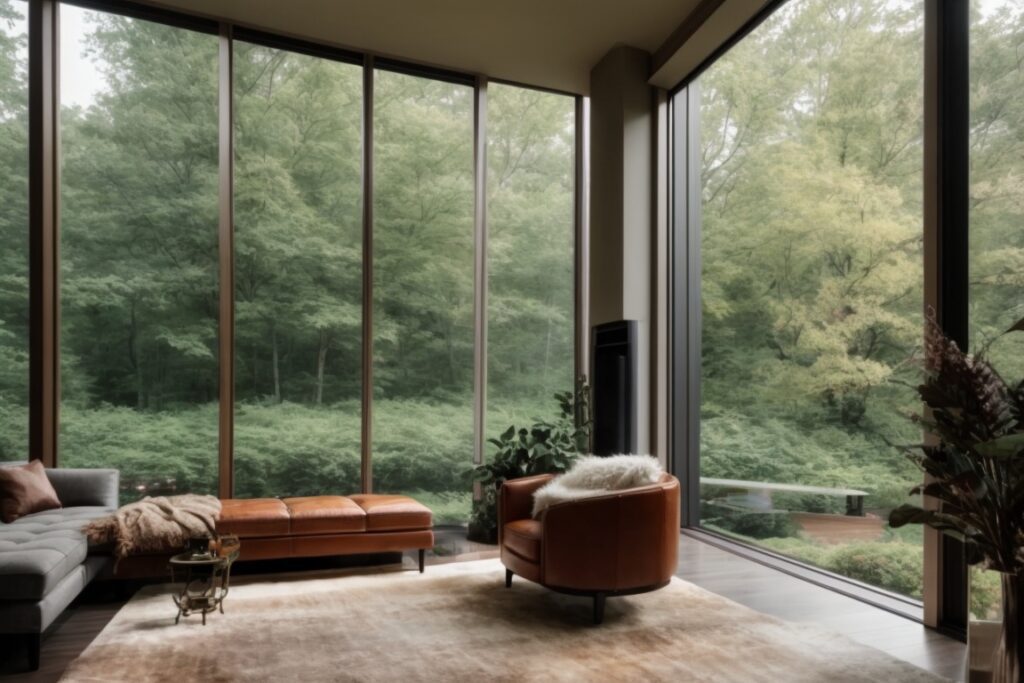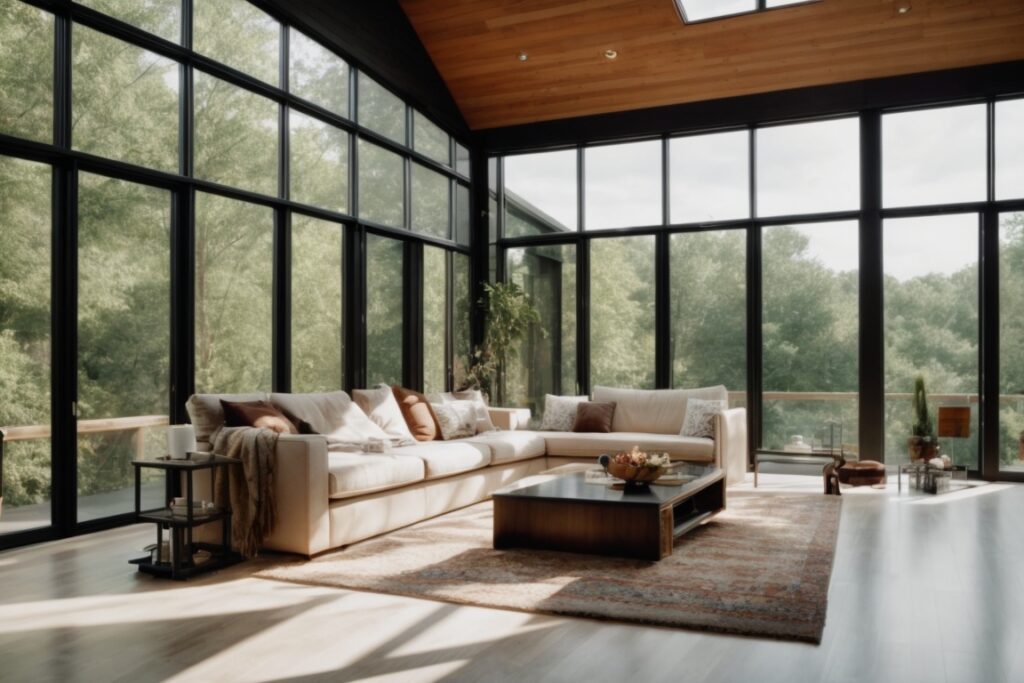Discovering the Shield: The Role of Low-E Window Film in Nashville’s Architecture
In bustling Nashville, a city admired for its vibrant music scene and historic landmarks, an architectural element is making waves for its subtle, yet impactful contribution to modern design and efficiency. Low-E window film, a potent solution for managing sunlight in light-drenched spaces, still flies under the radar of many property owners. The charm of Nashville’s skyline, illuminated by the Tennessee sun, conceals the silent challenge faced by its buildings: energy loss and UV damage, exacerbated by extensive sunlight exposure.
Low-E window film in Nashville offers a protective barrier that not only enhances the aesthetic appeal of spaces but also transforms them into bastions of energy efficiency and comfort. Despite its benefits, the awareness surrounding this technology remains limited among Nashville residents. The energy-saving potential and protective qualities against UV rays provide compelling reasons for its adoption, yet the layer of skepticism rooted in unfamiliarity persists. This technology, capable of reducing energy bills and protecting interiors from sun damage, stands at the threshold of widespread acceptance.
As we navigate through the intersections of innovation, sustainability, and design, the conversation around Low-E window film becomes increasingly pertinent. In a city that prides itself on a blend of traditional charm and modern flair, the adoption of such energy-efficient solutions could mark a significant transformation. The essence of Nashville’s architectural evolution could be significantly influenced by the broader acknowledgment and application of Low-E window film, challenging the norms of how we perceive the role of sunlight in our built environments.
The Rising Concern: Low-E Window Film in Nashville’s Ever-Shining Environments
In Nashville, a beacon of vibrancy and cultural luminescence, there emerges a pressing issue concerning the management of sunlight within its light-drenched spaces. While the city basks in ample sunlight, enhancing the beauty and energy of its interiors, the very source of this brilliance brings with it a challenge – excessive heat and potential UV damage. The concept of low-E window film surfaces as a pivotal innovation amidst this predicament. This technology aims to harness the benefits of natural light while mitigating its downsides, such as increased energy costs and the risk of fading for interior furnishings.
The primary issue, thus, circles around finding a balance. Nashville’s architectural charm lies in its ability to welcome light, yet without a sustainable method to control this light, residents and businesses face increased heating bills and potential harm to the interior aesthetic integrity. Traditional solutions like heavy drapes or completely tinted windows undermine the city’s natural vibrancy, signaling a clear gap in the current approach to managing sunlight exposure. Low-E window film promises a middle ground, offering to elevate Nashville’s spaces without sacrificing their luminous appeal.
Unexpected Efficiency: The Surprising Impact of Low-E Window Film in Nashville
In the vibrant heart of Nashville, where sunlight streams into homes and buildings year-round, the adoption of low-e window film is marked by startling statistics that illuminate its necessity. With over 215 sunny days per year in Nashville, the energy consumption for cooling interiors can skyrocket. Remarkably, low-e window films can reduce this energy demand by up to 30%, significantly cutting down utility bills for residents. More than just a cost-saving measure, these window films also block up to 99% of harmful UV rays, protecting interior furnishings from fading—an essential consideration in a city blessed with abundant sunlight.
The Problem with Inadequate Window Insulation in Nashville
In Nashville’s climate, where the brilliance of the sun is a constant, the problem of insufficient window insulation becomes glaringly evident. Many residents face the challenge of keeping their homes comfortable without incurring astronomical energy bills. The crux of this issue lies in the use of inefficient window films or, in some cases, the complete absence thereof. This inadequacy leads to excessive heat gain during the summer months and significant heat loss when winter arrives, thereby straining heating, ventilation, and air conditioning (HVAC) systems beyond their intended capacities.
The use of regular glass windows without low-e window films exacerbates this problem. Standard glass does little to prevent the transfer of heat, meaning that during the summer, homes can become uncomfortably hot, forcing air conditioning units to work overtime. Conversely, in winter, the same windows allow heat to escape, leading to increased usage of heating systems. This not only impacts the comfort levels within these spaces but also leads to higher energy consumption, which translates into heftier utility bills for homeowners.
Moreover, the absence of low-e window film compromises the protection of interior furnishings from the damaging effects of UV radiation. Prolonged exposure to sunlight can fade furniture, carpets, and artworks, undermining the aesthetic appeal and value of the home’s interior. Therefore, the problem extends beyond discomfort and financial implications to include the potential loss of personal belongings that hold both economic and sentimental value.
This issue is particularly pertinent in Nashville, a city known for its vibrant sunshine and distinct seasons. Without adequate window insulation, residents find themselves caught in a cycle of discomfort and elevated expenses, underscoring the necessity of a solution that addresses both the thermal efficiency and protective needs of their homes.
Understanding the Problem: The Impact of Inadequate Window Film in Nashville’s Climate
Nashville homeowners face a unique challenge due to its geographical location and climate, which includes hot summers and relatively mild but unpredictable winters. Inadequate window film, or the absence of low-e window film, exacerbates the city’s fluctuating temperatures within residential and commercial spaces, leading to a series of problems that can affect everyday living and work environments.
The core issue arises from standard glass windows’ inability to effectively manage and reflect away the sun’s ultraviolet (UV) rays. This not only increases the temperature inside homes and buildings during the summer but also contributes to the fading of furniture, floors, and draperies. The consequence is an increased dependency on air conditioning for cooling, which in turn leads to higher energy bills. During the cooler months, the absence of low-e window film results in heat loss, making it difficult to maintain a comfortable indoor temperature without an excessive use of heating systems. Understanding this problem is crucial for Nashville’s residents, as it directly impacts their comfort, energy consumption, and ultimately, their utility expenses.
Enhancing Nashville’s Historic Charm with Low-E Window Film
In the bustling heart of Nashville, the historic Brownstone Theater, a cherished landmark, faced the challenge of preserving its antique charm while improving energy efficiency. The introduction of low-E window film became a case study in balancing aesthetics with modern needs. Just months after the installation, the theater reported a significant reduction in energy consumption, all while protecting its interior from UV damage without altering its iconic appearance. This real-life example demonstrates the effectiveness of low-e window film in Nashville’s diverse architectural landscapes, making it an ideal solution for others facing similar challenges.
Consequences of Ignoring Low-E Window Film in Nashville
Ignoring the installation of low-e window film in Nashville’s radiant environments can lead to a series of adverse outcomes that affect both your comfort and wallet. The absence of this protective layer on your windows has more implications than one might initially realize.
Without low-e window film, the excessive sunlight that enters your spaces can cause your furniture, carpets, and artworks to fade prematurely, thus depreciating their value and aesthetics over time. This is a direct consequence of ultraviolet and infrared light constantly penetrating your living or workspace, which could have been easily mitigated with low-e window film.
Moreover, the increased solar heat gain from not using low-e window films contributes significantly to higher energy bills. Your HVAC system has to work overtime to compensate for the additional heat, leading to costly utility bills and potential overuse of your climate control systems, which may reduce their lifespan.
In summary, neglecting to install low-e window film in Nashville’s light-filled environments not only increases your energy costs but also jeopardizes the longevity and beauty of your interior décor and comfort. The decision to overlook this solution can, therefore, have lasting negative impacts on both your financial well-being and quality of life.
Economic Security Enhanced by Low-E Window Film in Nashville
Installing low-e window film in your Nashville home can significantly improve your economic security. This upgrade not only reduces energy bills by retaining heat in winter and reflecting heat in summer but also extends the lifespan of your furnishings by protecting them from UV damage. Over time, the savings on heating, cooling, and replacement costs can accumulate, making it a financially sound decision. Furthermore, homes with energy-efficient improvements such as low-e window films often attract higher resale values, enhancing your investment in the long-term.
Enhancing Nashville Homes with Low-E Window Film
In the radiantly lit landscapes of Nashville, where the sun generously bestows its light, managing indoor light levels and temperatures can be a challenging task for homeowners. Low-E window film emerges as a tailored solution to the unique challenges faced by residents in this sun-drenched city. This section will focus on how low-E window film uniquely addresses the issues of excessive sunlight, energy consumption, and privacy while ensuring homes stay beautifully illuminated without the drawbacks.
Low-E window film is designed to reflect and filter the sun’s rays, significantly reducing glare and heat transfer into homes. This attribute is particularly beneficial for Nashville’s architecture, which often features large, picturesque windows designed to capture the beauty of the surrounding landscapes. By installing low-E film, homeowners can enjoy their views without the discomfort of excessive heat and glare, enhancing the livability of light-filled spaces.
Moreover, with energy efficiency at the forefront of homeowners’ concerns, low-E window film offers an answer to escalating heating and cooling costs. By improving the thermal efficiency of windows, it contributes to maintaining consistent indoor temperatures. This not only reduces the reliance on HVAC systems but also leads to noticeable savings on energy bills. The implementation of this film aligns with the growing trend towards sustainability, offering Nashville residents a way to minimize their carbon footprint without sacrificing comfort or aesthetic appeal.
Additionally, the low-E window film provides an added layer of privacy and protection, by subtly tinting the windows without blocking out the natural light. This ensures that homes remain bright and inviting, while also securing the privacy of residents against the prying eyes of the outside world.
Enhancing Nashville Homes with Low-E Window Film
Low-E window film emerges as a compelling remedy for Nashville homes bathed in natural light. This innovative product is tailored specifically to address the downsides of extensive sunlight exposure while enhancing the benefits. Low-E window film effectively reduces heat gain within a space, making it a critical tool against Nashville’s sweltering summer temperatures.
By reflecting and filtering out the sun’s harmful UV rays, it not only cools down the interior of homes but also protects furnishings and flooring from fading. This level of protection extends the life of interior decorations, offering long-term savings and maintaining the vibrant aesthetics of the home’s interior. Furthermore, low-E window film increases the efficiency of heating and cooling systems by stabilizing the internal temperature, resulting in lower energy bills.
The application of low-E window film in Nashville’s light-drenched spaces allows homeowners to enjoy the beauty of natural sunlight without its detrimental effects, embodying a perfect blend of functionality, energy efficiency, and protection against the harsh Tennessee sun.
Benefits and Features: Embracing Low-E Window Film in Nashville
Low-E window film in Nashville shines with a spectrum of advantages for both residential and commercial spaces. A significant benefit is its efficacy in reducing energy costs by minimizing heat transfer, thus maintaining interior temperatures without overburdening HVAC systems. This film also filters harmful UV rays, protecting furnishings and flooring from fading, while enhancing the natural light in a room for a brighter, more inviting atmosphere. Its application adds an extra layer of privacy and security without compromising the view or the aesthetics of the building. For Nashville buildings, low-E film is a smart investment, blending functionality with improved energy efficiency and comfort.
Transforming Nashville Residences with Low-E Window Film
In Nashville, a city known for its vibrant sunrises and radiant daylight, homeowners and commercial space owners alike are discovering the transformative effects of low-e window film. One standout success story comes from the White family in the suburban areas of Nashville. After installing low-e window film throughout their residence, they were struck by the considerable decrease in indoor temperatures, even at the peak of summer. The Whites reported a significant reduction in their energy bills, attributing this cost-saving directly to the enhanced efficiency of their windows.
Another testimony that echoes the effectiveness of low-e window film comes from a local café in the bustling heart of Nashville. The owner, Ms. Harper, decided to give her establishment a much-needed upgrade with low-e window film to tackle the glaring afternoon sun that would often deter customers. Post-installation, the café not only retained its welcoming ambiance throughout the day but also saw a noticeable decrease in air conditioning costs. Ms. Harper enthusiastically shared that her investment in low-e window film has been recouped several times over due to the savings on energy bills and the increase in customer satisfaction and comfort.
Transforming Nashville Homes: The Elegance of Low-E Window Film
In Nashville, a historic home faced the challenge of preserving its aesthetic while improving energy efficiency. The installation of Low-E window film presented an ideal solution, blending seamlessly with the home’s character. Post-installation, the homeowners noted a significant reduction in heat gain during summer months and improved insulation during colder periods, leading to lower energy bills and enhanced comfort. This case exemplifies the effectiveness of Low-E window film in maintaining architectural integrity while bolstering energy efficiency. Ready to transform your living space? Contact us today to explore the benefits of Low-E window film for your Nashville home.







About The Author: Nvwfadmin
More posts by nvwfadmin